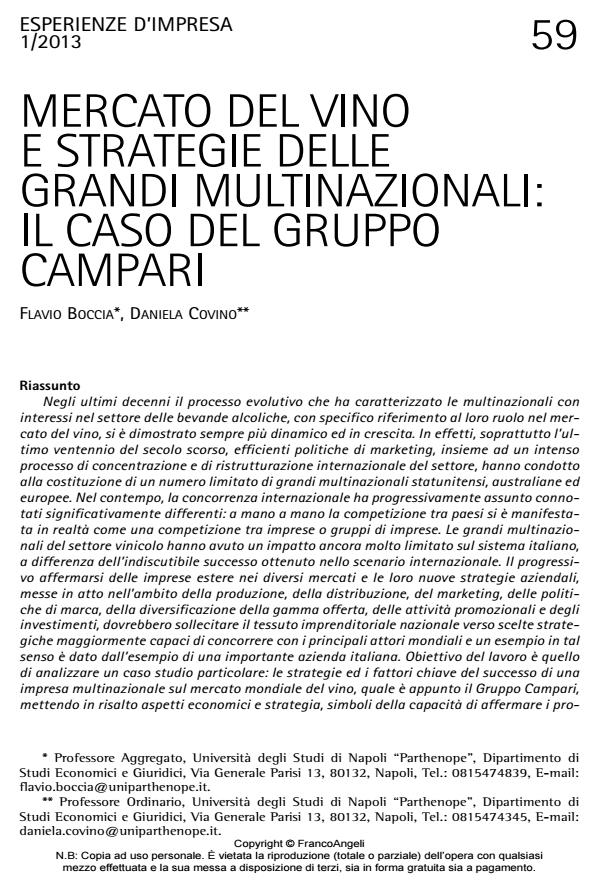Wine market and big companies’ strategies: the campari group case
Journal title ESPERIENZE D'IMPRESA
Author/s Flavio Boccia
Publishing Year 2013 Issue 2013/1
Language Italian Pages 20 P. 59-78 File size 295 KB
DOI 10.3280/EI2013-001003
DOI is like a bar code for intellectual property: to have more infomation
click here
Below, you can see the article first page
If you want to buy this article in PDF format, you can do it, following the instructions to buy download credits

FrancoAngeli is member of Publishers International Linking Association, Inc (PILA), a not-for-profit association which run the CrossRef service enabling links to and from online scholarly content.
The evolutionary process that has characterized the multinational alcoholic beverage companies, with specific reference to their role in the wine market, proves to be always-growing and more dynamic. That is also thanks to efficient marketing policies, and to an intense international concentration and reorganization process of the alcoholic beverages sector which has brought to the establishment of a limited number of huge American, Australian and European multinational companies. At the same time, international competitive has deeply changed: today, we can no more talk about competition between countries, but we have to refer to competition between companies or groups of companies (often results of combination and take-over processes, also by actors completely unrelated to the market, as financial companies, insurance groups, merchant banks). The Old world of wine and the New one are not strictly opposed: the real difference is between companies which have focused on winning market-oriented strategies and those which have remained product-oriented. The effects of the strategies of the main multinational beverage companies in the Italian wine sector are still very limited, differently from the undoubted world success obtained: by the right changes, Italy (already at the top of international wine market) could conform itself to the new requirements of entrepreneurial competition and have a special attention to the way companies relate with the market. The progressive growth of foreign multinational companies in different markets and their new company strategies, regarding production, distribution, marketing, brand policies, product diversification, promotional activities, investments and social responsibility, should push the universe of Italian small and medium enterprise to follow action lines that are capable to let them compete with the main global actors, with good chances to succeed, according to the model guide of Campari Group. The goal of the present work is to analyse a case study: the strategies and the key factors of the success of one multinational company on the world wine market (the Italian Campari Group) and to show economic aspects and successful strategy, as well as the ability to assert its products in more competitive markets, such as those ones of the New world wine countries. .
Keywords: Company, enterprise, market, strategy, trade, wine
- New Money in Rural Areas Nick Gallent, Iqbal Hamiduddin, Meri Juntti, Nicola Livingstone, Phoebe Stirling, pp.33 (ISBN:978-981-13-0769-0)
Flavio Boccia, Mercato del vino e strategie delle grandi Multinazionali: il caso del Gruppo Campari in "ESPERIENZE D'IMPRESA" 1/2013, pp 59-78, DOI: 10.3280/EI2013-001003